Looking to add structure and beauty to your outdoor space? DIY retaining wall projects are a perfect solution. These walls not only prevent soil erosion but also build more usable land by transforming steep slopes into terraced backdrops. With 18 easy DIY retaining wall ideas, this guide offers a comprehensive look into how to build a retaining wall that suits your needs. From selecting materials to detailed construction steps, we’ve covered you with helpful tips.
Before diving into the construction, understanding the basics of a retaining wall and planning your project are crucial steps. Our guide lays out a step-by-step construction guide, including preparing the ground, laying the first row, building up, and finishing touches. Also, don’t miss our tips for success and FAQs on DIY Retaining Walls to tackle common challenges and ensure your project’s longevity. Ready to enhance your landscape? Let’s take a closer look at how to build a simple DIY retaining wall.

Why Build a DIY Retaining Wall?
Constructing a DIY retaining wall in your garden or yard not only offers practical benefits but can also be a fulfilling project. Here’s why you might consider building one yourself:
- Erosion Control: Retaining walls are essential for holding soil in place on slopes, preventing the loss of soil and the damage caused by erosion.
- Expand Usable Space: By terracing sloped areas, retaining walls Build level sections of land, providing more usable space for gardening, play areas, or outdoor living.
- Aesthetic Appeal: A well-constructed wall can be an attractive feature in your landscape, adding structure and visual interest to your outdoor space.
- Cost-Effective: Doing it yourself can be significantly cheaper than hiring professionals, allowing you to allocate funds elsewhere or invest in higher quality materials.
- Customization: DIY allows you to choose materials and designs that perfectly match your vision and landscape, building a personalized touch that might not be possible with pre-built solutions.
- Sense of Achievement: Completing a retaining wall project yourself can give you a sense of pride and satisfaction, knowing that you’ve improved your property with your own hands.
Remember, before you begin, it’s crucial to plan your project thoroughly, choose the right materials, and understand local building codes to ensure a safe and successful build. With patience and effort, your DIY retaining wall will stand as a testament to your hard work and dedication.
How to Build a Simple DIY Retaining Wall
Building a DIY retaining wall in your garden or yard can serve multiple purposes: preventing soil erosion, building usable space on slopes, and adding aesthetic value to your outdoor area. With this guide, we aim to provide you with a simple yet effective way to construct a retaining wall, ensuring durability, functionality, and style. Our approach is designed to be straightforward, ensuring you feel confident and equipped to tackle the project, regardless of your experience level.
Understanding the Basics
Before we dive into the construction process, let’s clarify what a retaining wall does. Essentially, it’s a structure designed to hold back soil, particularly in areas where abrupt changes in elevation could lead to soil erosion. Besides its functional role, a retaining wall can also transform your landscape, providing a unique opportunity to enhance your garden’s design.
Planning Your Retaining Wall
- Assess the Location: Identify where you need the wall. Consider areas with noticeable soil erosion or slopes you wish to make more functional.
- Choose Your Materials: Options include concrete blocks, stones, or pressure-treated lumber. Each material offers different aesthetic and durability characteristics.
- Understand Local Regulations: Some areas may require permits for retaining wall construction, especially if the wall exceeds a certain height.
Step-by-Step Construction Guide
Preparing the Ground
- Mark the Area: Use stakes and string to outline where your wall will be built.
- Excavate: Dig a trench along the marked line. The trench should be about 4-6 inches deep and wider than the blocks or materials you’re using.
- Compact the Base: Use a hand tamper or plate compactor to compact the soil in the trench, building a solid base for your wall.
Laying the First Row
- Add Gravel: Fill the trench with a layer of gravel. This helps with drainage and provides a level base.
- Set the First Block: Carefully place your first block or stone in the corner of the trench. Use a level to ensure it’s perfectly horizontal.
- Continue the Row: Place the next blocks, ensuring they’re tightly pressed against each other and level. This first row is crucial as it sets the alignment for the rest of your wall.
Building Up
- Stack Additional Rows: Continue stacking your blocks or materials, offsetting them as needed for stability. Check for levelness with each row.
- Backfill: As you build up, backfill the area behind the wall with gravel to enhance drainage.
- Incorporate Weep Holes: If using concrete blocks, leave space for weep holes every few feet to allow water to escape, preventing pressure buildup.
Finishing Touches
- Top it Off: Once you reach the desired height, you can add capstones or a final row of blocks for a clean finish.
- Landscape: Consider planting shrubs or flowers along the wall or adding mulch for a polished look.
Tips for Success
- Lean the Wall: For additional stability, the wall should lean slightly back into the hillside, about 1 inch for every 12 inches of height.
- Consider Drainage: Proper drainage is key to preventing water pressure from building up behind the wall. A French drain system or gravel backfill can be effective solutions.
- Be Patient: Take your time with each step, especially when ensuring the base is level and compact. This foundation determines the stability and appearance of your finished wall.
Building a retaining wall may seem like a daunting project, but with the right preparation and steps, it’s an achievable and rewarding endeavor. Not only will you protect your property from erosion, but you’ll also gain valuable landscaping experience and improve the overall aesthetics of your outdoor space.
FAQs on DIY Retaining Walls
Discover all you need to know about DIY retaining walls in our comprehensive FAQs guide. Find tips, techniques, and answers to your burning questions here.
What is a retaining wall?
A retaining wall is a structure designed to restrain soil to a slope that it would not naturally keep to (typically a steep, near-vertical or vertical slope). It’s used to Build usable land on slopes, prevent erosion, and can add aesthetic appeal to your garden or yard.
Why build a DIY retaining wall?
- Erosion Control: It helps in preventing soil loss and erosion.
- Expanding Usable Space: Terracing sloped areas Build more usable space for gardening or other activities.
- Aesthetic Appeal: Adds visual interest and can be a focal point in your landscape.
- Cost-Effective: Building it yourself can save money.
- Customization: DIY allows for material and design choices that fit your exact needs and vision.
- Sense of Achievement: Completing such a project brings a sense of pride and enhances your property.
What materials can I use for a DIY retaining wall?
- Concrete Blocks: Popular for their strength and ease of assembly.
- Stones: Natural stones provide an aesthetic and natural look.
- Pressure-Treated Lumber: Good for a wood-textured finish and affordability.
- Bricks: Offers a classic appearance.
How do I plan and start building a DIY retaining wall?
- Assess the Location: Identify erosion issues or areas you want to terrace.
- Choose Your Materials: Consider the look, cost, and longevity of materials.
- Understand Local Regulations: Check if permits are required based on the wall’s height and your area’s building codes.
- Prepare the Site: Clear the area, dig a trench for the base, and ensure a solid, level starting point.
How do I ensure proper drainage for my retaining wall?
Incorporate a drainage system behind the wall, like:
- Gravel Backfill: Fill the space behind the wall with gravel to facilitate water flow.
- Drainage Pipe: Install a perforated drainage pipe at the base behind the wall to carry water away.
- Weep Holes: For concrete walls, leave spaces for weep holes to let water escape.
What are some common challenges in building a DIY retaining wall?
- Ensuring Stability: Walls taller than 4 feet may require additional reinforcement.
- Drainage Issues: Poor drainage can lead to water pressure that may destabilize the wall.
- Choosing the Right Materials: Needs vary based on climate, soil, and intended use of the land.
- Legal Restrictions: Failing to adhere to local building codes can result in fines or required alterations.
Can I build a retaining wall on a slope?
Yes, retaining walls are often built on slopes to Build flat, usable spaces or to prevent erosion. The key is to start with a solid, level base and consider the wall’s height and the slope’s steepness. Terracing, or building multiple small walls, might be a better solution for steeper slopes.
How long does a DIY retaining wall last?
The lifespan of a retaining wall depends on the materials used and how well it’s built, especially the foundation and drainage system. With proper construction and maintenance:
- Concrete and Stone Walls: Can last 50 years or more.
- Wood Walls: Last around 20 years, depending on the type of wood and exposure to moisture.
Do I need professional help to build a retaining wall?
For smaller walls (up to 3-4 feet high), DIY is quite feasible with proper planning and effort. For taller walls, consulting a professional is advised due to the complexity of structural and drainage considerations. Always check local regulations, as some may require professional input or permits.
18 DIY Retaining Wall Ideas
Discover 18 creative DIY retaining wall ideas for your outdoor space. From stacked stone to wooden walls, explore clever retaining wall designs to enhance your landscape.
1. How to Build a Block Retaining Wall
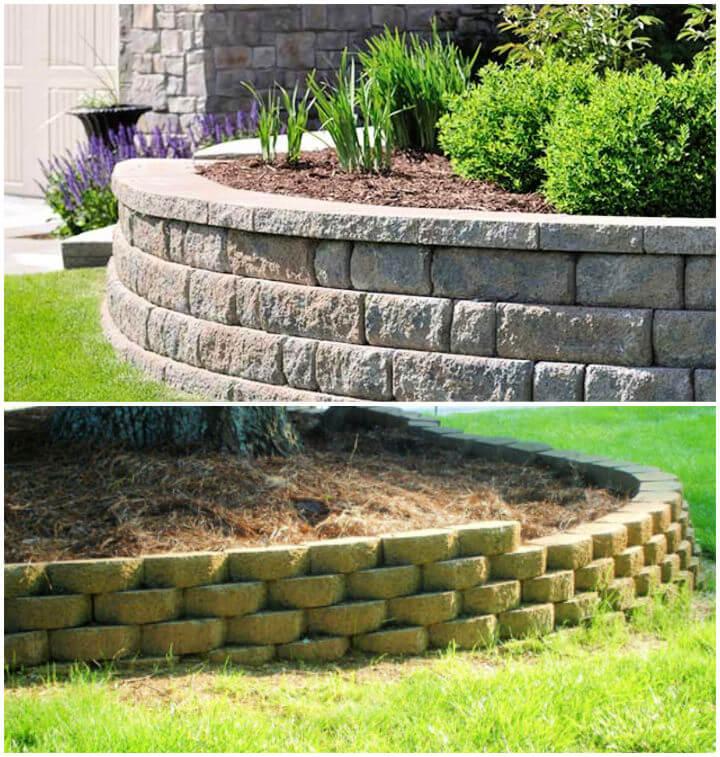
Building a block retaining wall can enhance your outdoor space by managing erosion and building aesthetically pleasing garden areas. Today’s Homeowner provides a comprehensive guide to help you construct a durable wall with interlocking, stackable concrete blocks.
This instructive content breaks down the process into manageable steps, from planning and trench digging to laying blocks and backfilling. With helpful tips and material lists, the guide is designed to ensure your project is successful, even if it’s your first time tackling such an endeavor. Dive into the detailed instructions to elevate your landscaping while also safeguarding against soil erosion.
Raised Garden Bed Plans: Learn how to start gardening with our ultimate guide to DIY raised garden bed plans. Get all the tips and tricks you need to Build your own garden oasis.
2. Easy DIY Retaining Wall
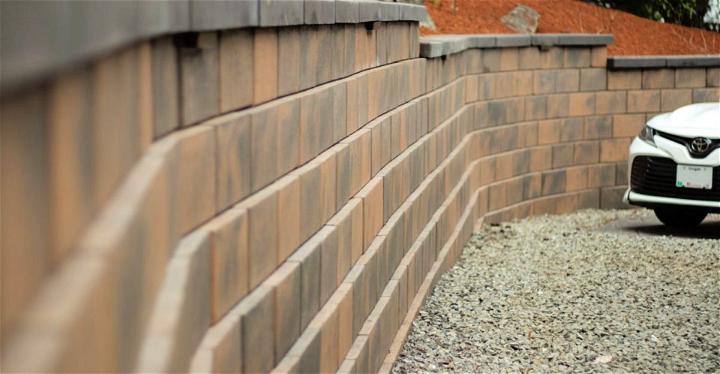
Ready to construct a sturdy retaining wall that lasts? Western Interlock‘s comprehensive guide is your go-to resource for a step-by-step tutorial on building a reinforced wall using Murata™ Retaining Wall Blocks. This instructional piece covers everything from groundwork and gravel bases to water drainage and wall capping, ensuring your structure stands firm for years. With an instructive and engaging tone, the guide is perfect for anyone eager to enhance their hardscaping skills. Get the support and expertise you need to complete your outdoor project with confidence and precision.
3. Build a Retaining Wall With Blocks
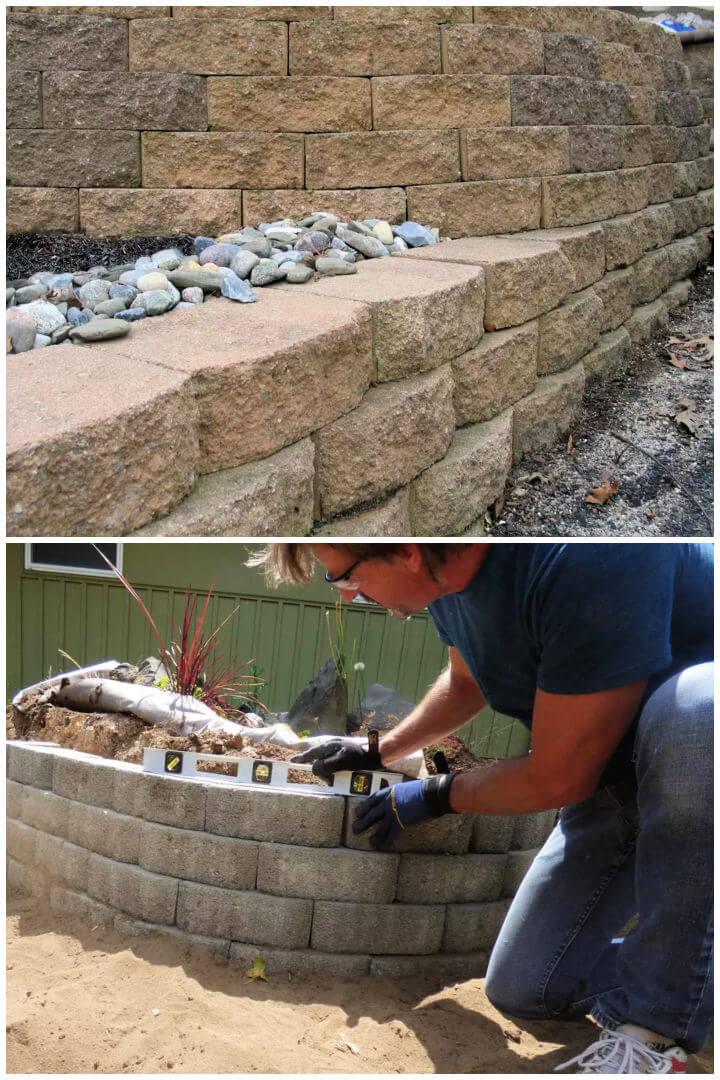
Building a retaining wall with blocks is an excellent way to combat soil erosion and Build functional, flat space in your yard. The Spruce offers an instructive guide to help you through the process, ensuring your DIY project is a success. With a focus on stability and proper drainage, this step-by-step tutorial covers everything from choosing the right location and materials to laying the first block and backfilling correctly. Dive into the detailed explanation to learn how to construct a long-lasting retaining wall that will enhance your landscape for years to come.
4. Adorable DIY Retaining Wall
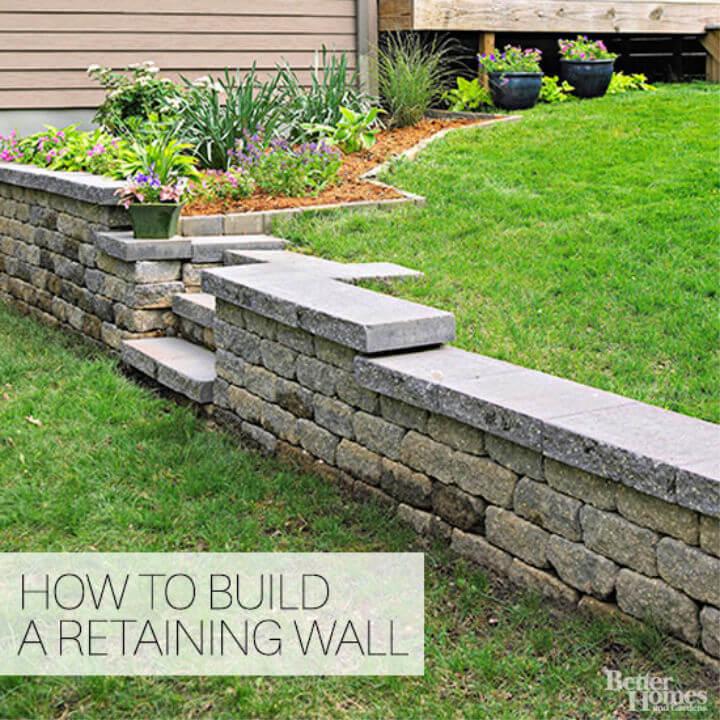
Transform your sloped garden into a functional and aesthetically pleasing outdoor space with a DIY retaining wall. Better Homes & Gardens offers a step-by-step guide on constructing a retaining wall on a slope, ensuring your project is manageable and fits your budget.
Learn to excavate, level, and stack blocks with precision, and explore how to enhance drainage for lasting stability. Complete your wall with capstones for a polished look. This engaging and helpful tutorial is tailored to support your landscaping vision with clear, relevant instructions.
5. Simplest, Cheapest DIY Retaining Wall
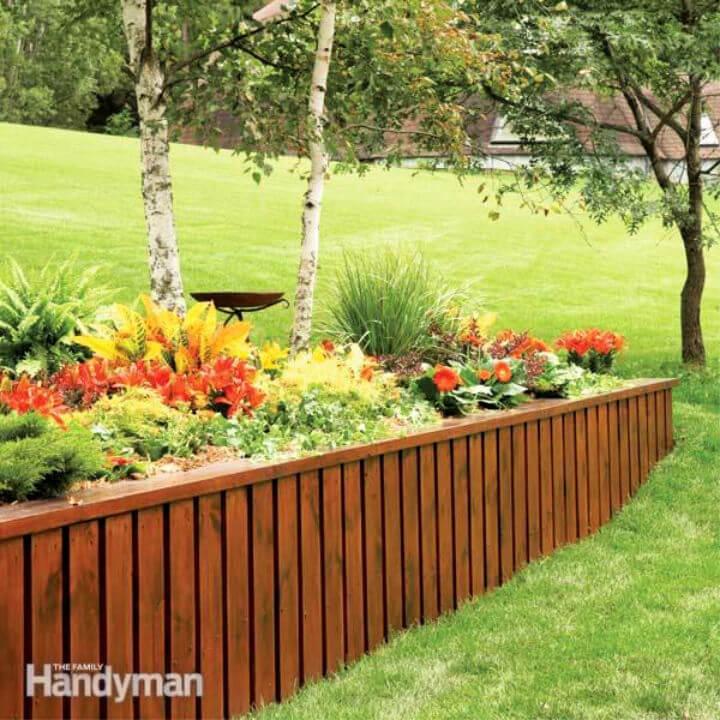
Building a retaining wall doesn’t have to be a backbreaking or costly endeavor. With Family Handyman‘s guide, you can construct an attractive and durable retaining wall from pressure-treated lumber and plywood. Ideal for do-it-yourself enthusiasts, this project simplifies the process, lightens the workload, and keeps your budget intact.
You’ll learn how to select the right materials, prepare the site, and assemble the wall with detailed, step-by-step instructions. From framing to backfilling, this guide covers all aspects to ensure your retaining wall stands the test of time. Dive into these instructions for a straightforward build that enhances both the functionality and appearance of your outdoor space.
6. DIY Retaining Wall for Your Garden
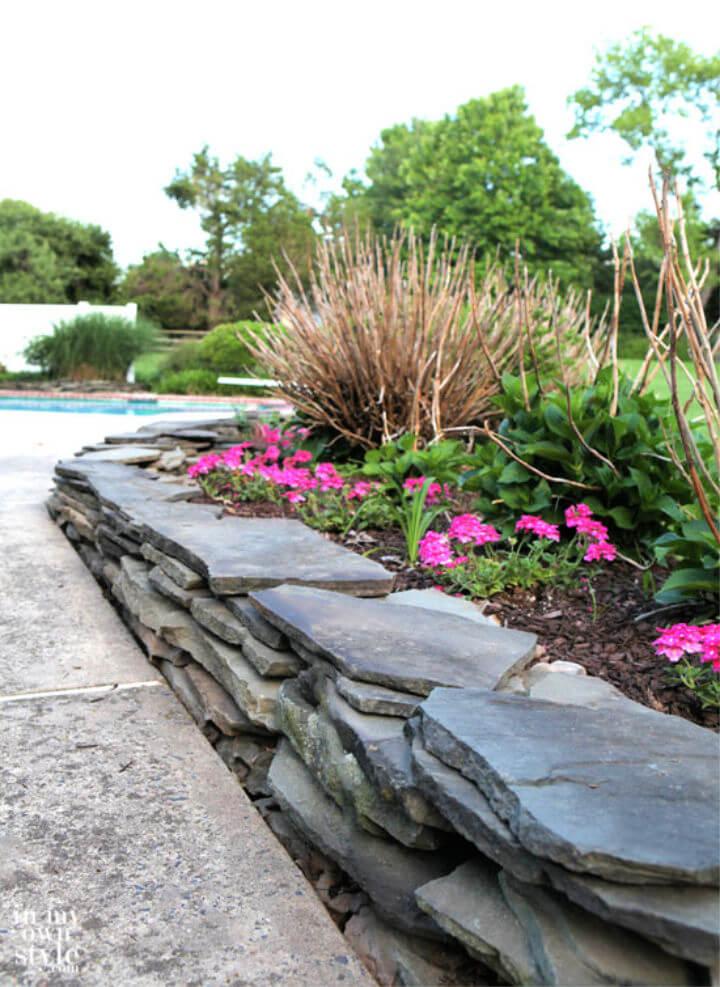
Making a fieldstone garden wall adds a rustic and natural charm to your outdoor space, and In My Own Style provides an accessible guide on how to do it yourself without the need for a contractor, mortar, or concrete. Diane Henkler shares a comprehensive step-by-step tutorial, complete with photos, to help you through the process.
With a focus on selecting the right fieldstones and assembling them like a puzzle, you can establish a beautiful and functional wall around your garden beds. The guide covers everything from material selection to the finishing touches, ensuring that anyone can enhance their landscape with this enduring feature.
7. How to Make Retaining Wall On a Slope
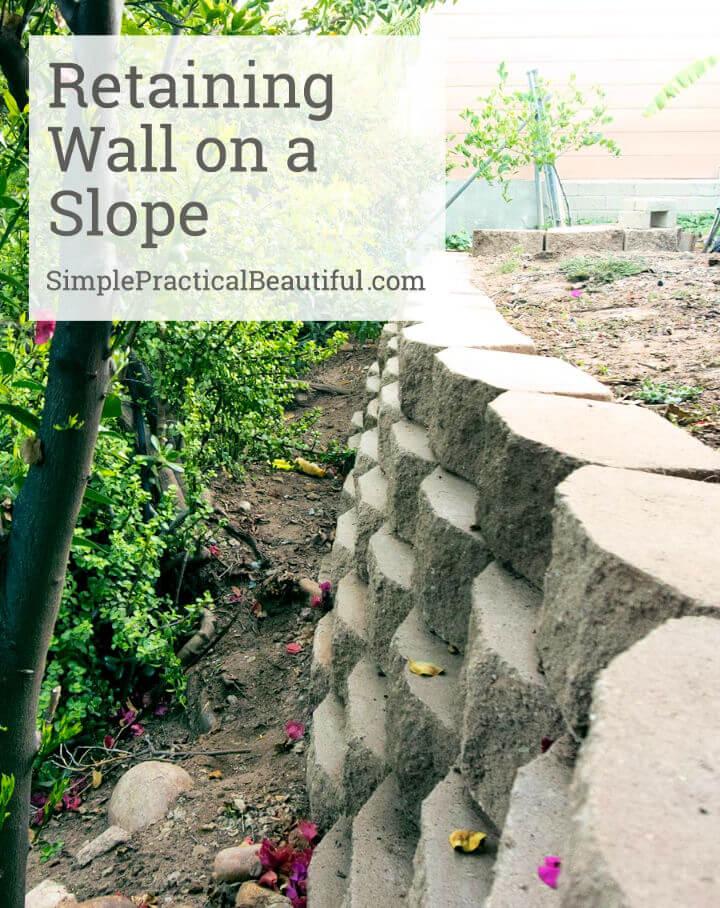
Making a DIY retaining wall on a slope can be a transformative project for your backyard, as demonstrated by Rebecca’s experience shared on Simple Practical Beautiful. Tackling a sloped garden might seem daunting, but with the right materials like interlocking bricks, gravel, and a French drain, even steep inclines can be converted into valuable, flat outdoor spaces.
The key to success is careful planning, ensuring a level first row, and considering proper drainage to maintain the wall’s integrity. If you’re ready to expand your usable yard area and enjoy a more spacious outdoor environment, learning from real-life projects like this can guide you through the process, making it both manageable and rewarding.
8. DIY Retaining Wall Using Pallets
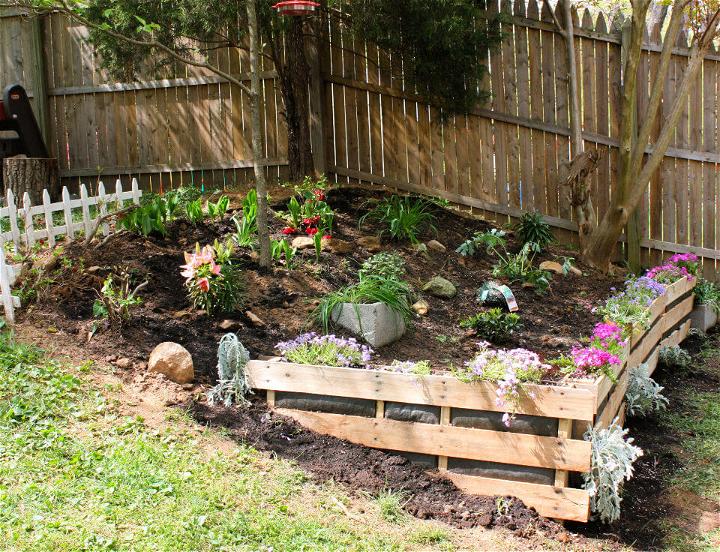
Explore creative upcycling with Buzzmills as they transform everyday pallets into charming and practical garden solutions. In a recent backyard endeavor, the team turned five free pallets from Freecycle into an aesthetic screen to conceal an air conditioner and a budget-friendly retaining wall. The blog guides readers through the process of priming, painting, and installing these wooden gems, showing that a touch of ingenuity can lead to impressive, cost-effective outdoor enhancements.
With helpful tips and a touch of humor, Buzzmills proves that upcycled pallet projects can not only beautify your space but also spark conversations among neighbors. Whether enhancing garden beds or crafting new furniture, see how repurposed materials can make a significant impact.
9. How to Build a Simple Retaining Wall
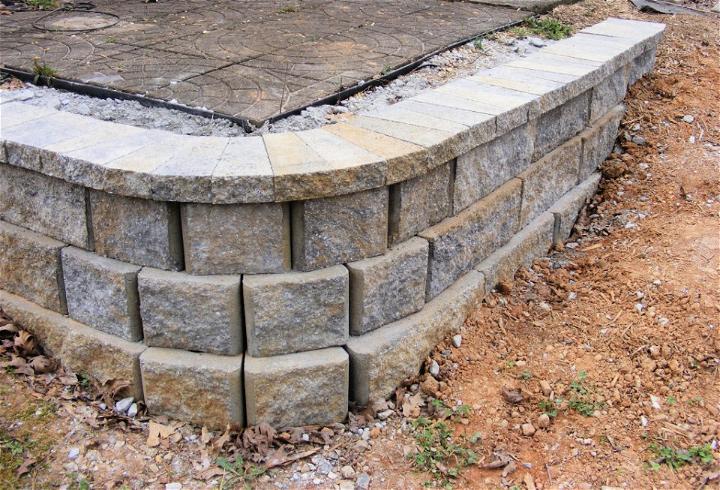
Building a simple retaining wall can be a great DIY project to enhance your outdoor space. To begin, select the right materials—blocks or stones specifically designed for retaining walls. Ensure that the ground is level and compact the soil to provide a sturdy base. Lay the first row of blocks carefully, checking for levelness as you go.
Use landscape adhesive or mortar between layers if needed for extra stability. Backfill with gravel for drainage, and remember to incorporate a slight backward lean into the wall for added strength. Always consult local building codes to ensure compliance and safety. With patience and attention to detail, you can Build a functional and attractive retaining wall. Four Oaks Crafts
10. DIY Perfect Retaining Wall
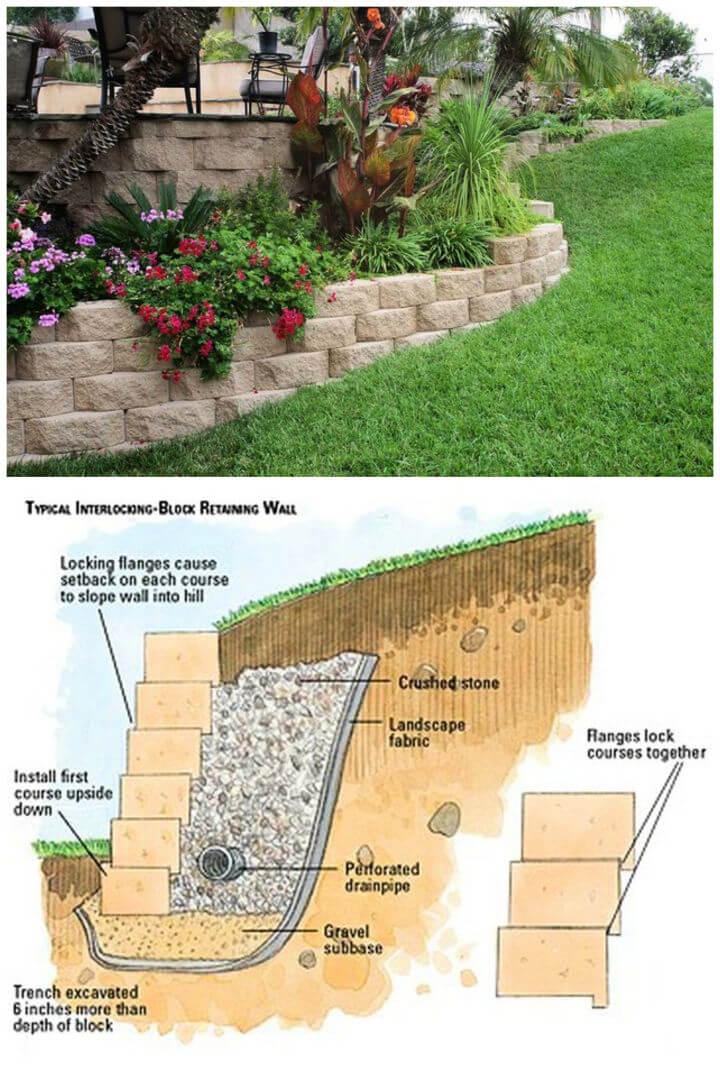
Transform your sloped garden into a beautiful and practical space with a retaining wall. Hunker‘s guide explains how retaining walls can Build flat areas for lawns, patios, or driveways, and offers insight on the construction, materials, and planning necessary for a durable and attractive wall.
Learn about the benefits of wood timbers, interlocking concrete blocks, and natural stone for building retaining walls that match your landscape needs and aesthetic preferences. For homeowners seeking to enhance their outdoor area while managing slopes, understanding retaining wall options is essential. Get ready to turn that challenging incline into a functional and stylish feature of your home.
11. Build Retaining Wall Construction for a Beautiful Garden
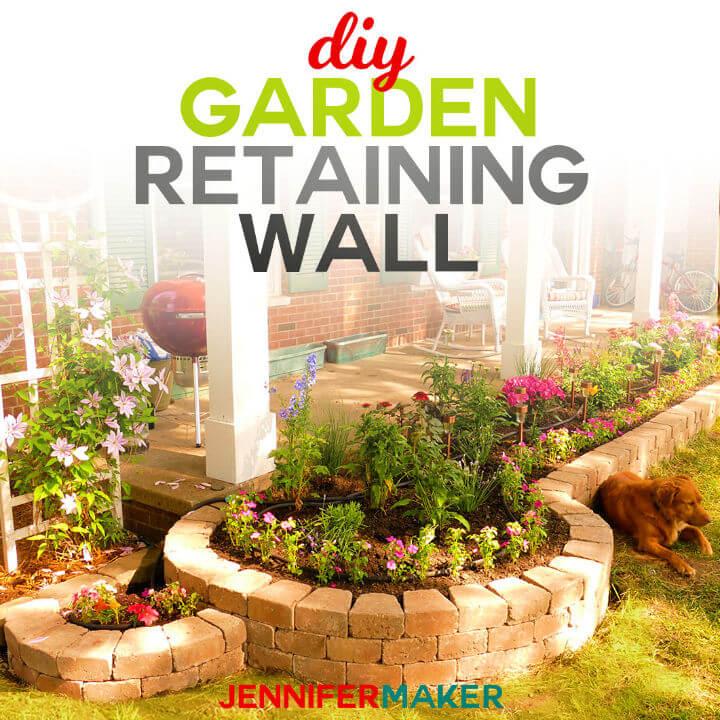
Transform your garden’s appeal with a stunning DIY retaining wall following the step-by-step guide on JenuineMom.com. This instructional piece provides a practical, budget-friendly approach to building a retaining wall that not only serves a functional purpose but also elevates the aesthetic of any outdoor space.
Learn to construct both straight and curved sections with ease, using detailed material lists and expert tips to ensure your wall stands strong and looks great season after season. Perfect for garden enthusiasts and DIYers, this resource is designed to make building a retaining wall an enjoyable and successful project.
12. Inexpensive DIY Block Retaining Wall
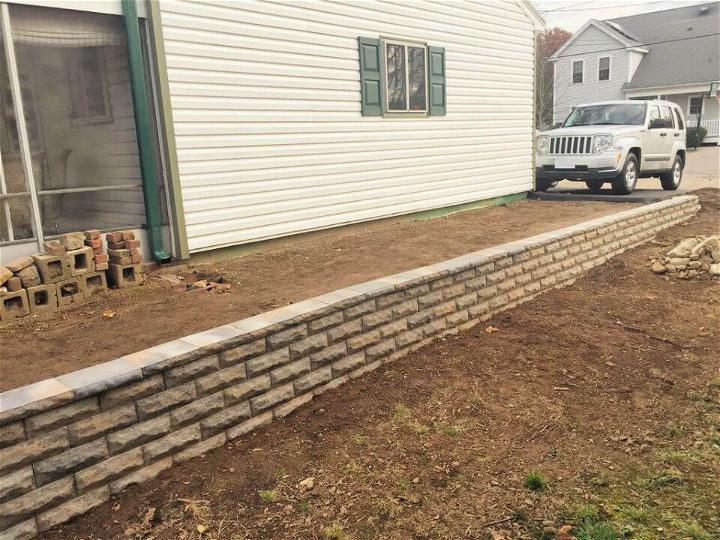
Ready to enhance your property with a functional and attractive addition? Instructables offers a detailed guide on constructing a block retaining wall, transforming unusable or sloping land into a level, more usable space. With step-by-step instructions, learn to measure, level, and stack blocks for a sturdy structure, even if it’s your first attempt at wall building.
This DIY project, requiring about 165 blocks and 30 bags of gravel, can significantly improve the look and utility of your yard. Follow this instructive, helpful tutorial to build a retaining wall that raises your landscaping game.
13. DIY Fence and Retaining Wall /DIY Wood Retaining Wall
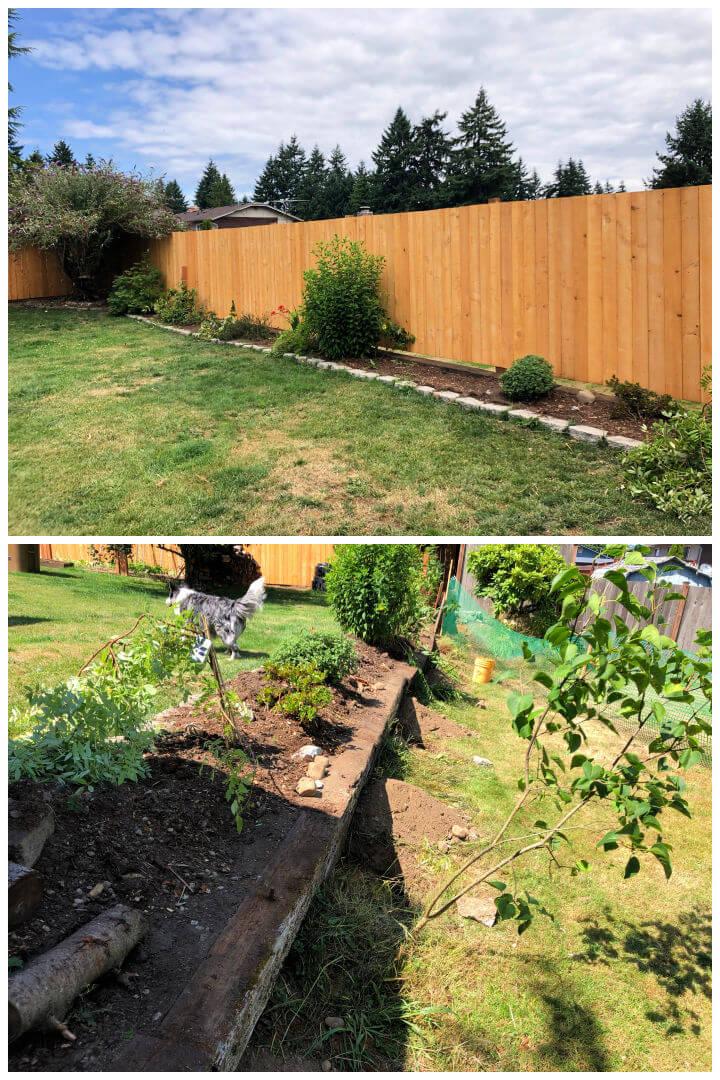
When it comes to home repairs, tackling fence and retaining wall issues can be quite daunting. Imgur offers an inspiring glimpse into a user’s successful project, highlighting the transformation of a dilapidated fence and wall into a sturdy and visually appealing structure. The user shares their journey from the initial state of disrepair, which was inherited from a previously abandoned house to the final touches that brought the outdoor space back to life.
By coordinating with neighbors and creatively reinforcing the existing fence, they achieved a functional and enhanced yard perimeter. For those facing similar outdoor repair challenges, this visual story provides practical insights and motivation to take on your projects with confidence.
14. Retaining Walls Around Trees
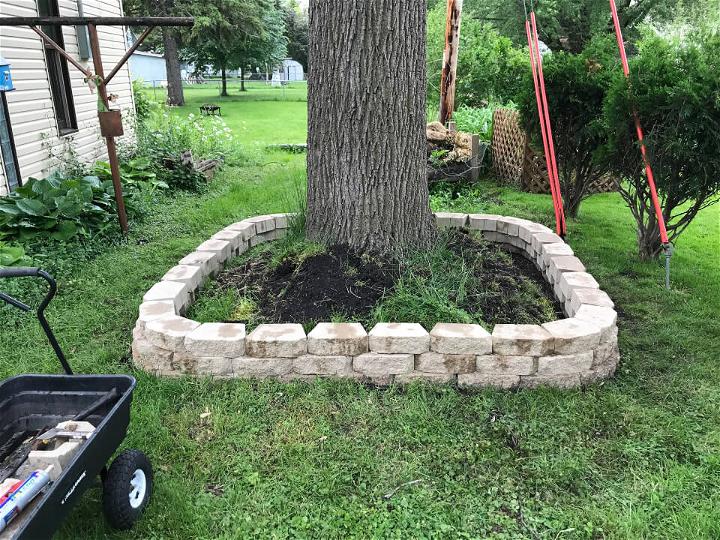
For garden enthusiasts, building a beautiful garden and exterior requires patience, determination, and proper care for tall trees. In this regard, a retaining wall serves as an excellent solution to address these concerns effectively. Discover the secrets to enhancing your outdoor space with ease!
15. Retaining Wall Bricks from Leaning Without Mortar
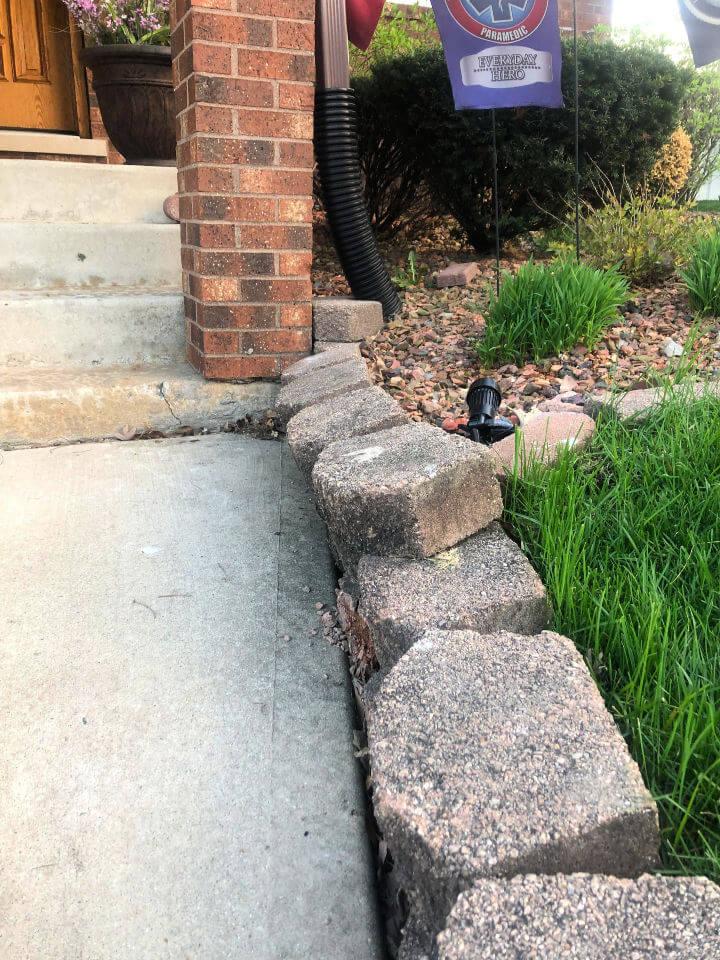
Retaining walls may lean and eventually collapse due to excessive soil and dirt accumulation. To prevent such occurrences, it is advisable to take precautionary measures. These include regular inspection of the wall’s roots and assessment for soil erosion in the surrounding area. Optimal maintenance is crucial to ensure the stability and longevity of retaining walls.
16. Retaining Wall 10 Feet at Roughly At 35 Degree Angle
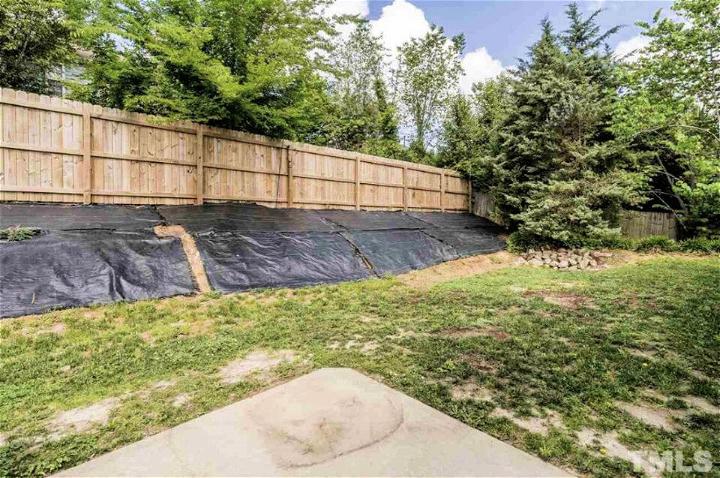
Constructing a DIY retaining wall on a sloping surface can be challenging, especially when aiming for a 10-foot length and a 35-degree angle. To achieve this, start by checking the ground level of the wall and work from the base.
17. Retaining Wall Made Of Redwood
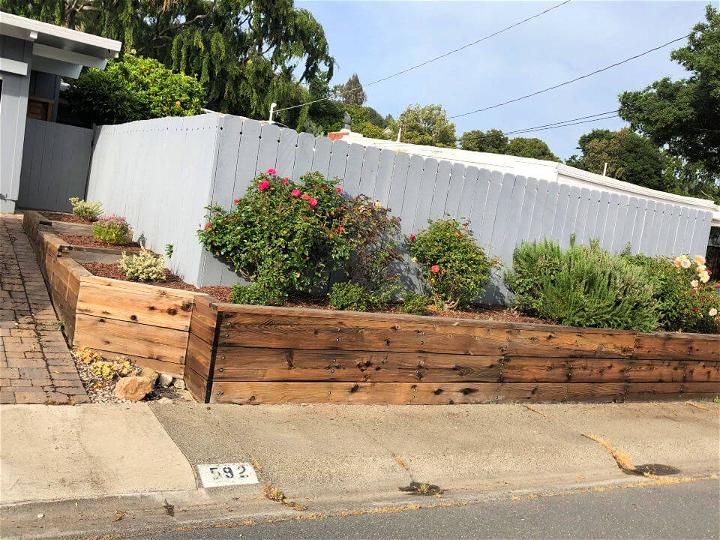
Redwood is an ideal wood that withstands all seasons. It is resistant to water, insects, and rot, making it perfect for use in retaining walls. Consider using it as a front retaining wall for your house. Adding dark paint on it, with a white background fence, can enhance the charm of your house’s exterior.
18. Stylish Look Retaining Wall Ideas
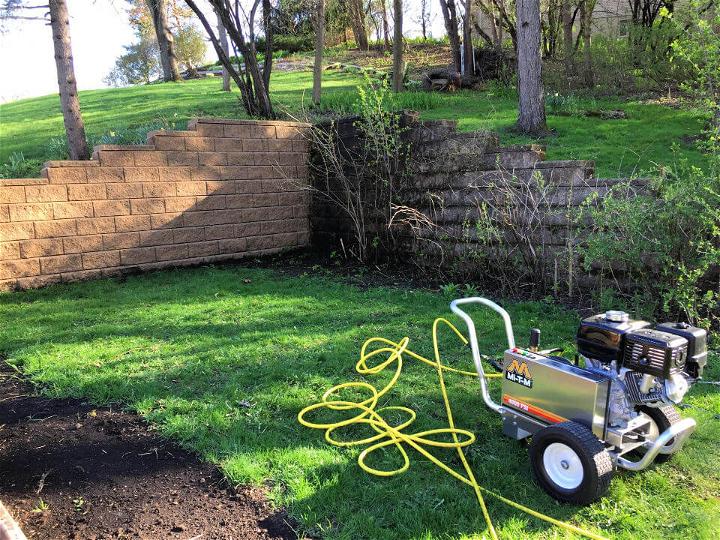
Retaining walls serve the dual purpose of soil protection and enhancing the aesthetics of your outdoor space. Why not consider using beautifully designed stones to construct the wall? These durable stones are not only weather-resistant but also help prevent erosion. Discover the benefits of incorporating stunning stone retaining walls in your landscape.
So if you have decided to go for a DIY retaining wall plan, you must have got all the facts straight by now! Because, well, that’s the first and most foremost step to do! With these 18 DIY retaining wall ideas, go brightening up your front or back yard with pebbles or stones or wood, the choices are literally just quite a lot!
Conclusion
In conclusion, embarking on the journey to construct your very own DIY retaining wall can transform not only the aesthetics of your outdoor space but also its functionality. This guide provided a comprehensive look into how to build a retaining wall, covering essential aspects from planning and groundwork to effective tips for ensuring longevity and stability. By carefully selecting the right materials and following the step-by-step construction process, you can enhance your property’s value and enjoy the rewards of your hard work.
Remember, a well-constructed DIY retaining wall not only supports soil but also opens up a realm of landscaping possibilities. So, grab your tools and let the creativity flow as you dive into building an impressive DIY retaining wall that stands the test of time.
